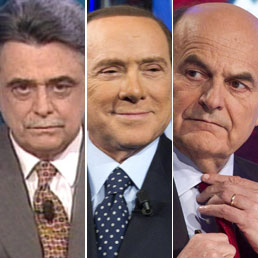Storia dell'articolo
Chiudi
Questo articolo è stato pubblicato il 25 febbraio 2013 alle ore 12:53.

In the first elections of the Second Republic it obtained 33.1% of the votes in the uninominal constituencies of the Lower House. For the proportional part it had 34.3% of the electors. If the Cavaliere had not stepped in, the left would have won and gone to power on its own for the first time in the history of the country. It was a possible result, thanks to the new rules of the majority system that would have transformed the 33.1% of the Progressisti votes into an absolute majority of the seats. If only the Italian right-wing had remained divided. Instead Berlusconi erupted on the scene and incredibly managed to put the majority of the pieces together. He won the elections and the left-wing had to postpone its date with history.
After 19 years we are back to where we started. The wheel has turned and today Berlusconi and the left are once again face to face, with Bersani in Occhetto's place. But what kind of left-wing? Today's left-wing is certainly not like that of 1994. A lot has happened in the meantime. There has been Prodi's Ulivo and Veltroni's PD. A piece of the radical left is no longer in today's left-wing. This is all true. Nevertheless, the coalition that Bersani is proposing to govern the country is not very unlike that of 1994. Its organizational and ideological core is still the same as the political machine of the PDS back then. Its electoral base is the same, more or less 34% of the votes. Of course, the electors are not the same. The moderate part has increased.
The PD has more votes than the PDS. Yet, its geographical and social base is still the same. Just like Occhetto's, Bersani's coalition is strong in the red areas of the country, among the workers and in the big cities. It is still weak in the North East. Today it still does not have an offer able to represent the interests of the productive class in this part of the country. Even if its leader certainly shows more attention towards the demands of the industrial sector.
Not much has changed in almost twenty years. But today the left could win. Once again, as could have happened in 1994, this would be thanks to the electoral system. It is not the same as then, but in any case, in the Lower House there is a hyper-majority system. With 34% of the votes Bersani and his ally Vendola could obtain 54% of the seats. If this actually happened, Bersani would have done what Veltroni was not able to do in 2008 with 37.5% of the votes. There is a definite reason for this: the fact that the right-wing is divided. With a united right-wing, this left-wing could not win.
It is the Berlusconi crisis that is making the difference with respect to 1994. Those within the PD who bet more on their identity than on a change were probably right. Renzi can wait. Sometimes in politics it is possible to win without
too many changes. It depends on the circumstances and on the rules. But we will only know for sure on Monday night. What we do know today is that, aside from Renzi, the PD preferred keeping the status quo. And so, just as in 1994, it gave up the idea of mixing the cards of Italian politics to create a new political and social block. Grillo is satisfying that demand for something new. Just like Berlusconi and Bossi did at the end of the First Republic. This time however the left could become the majority in the Lower House thanks to a generous electoral system. Although there will be a minority governing a country in which the majority continues to be culturally and politically right-wing.
But at least there is a left-wing able to govern today. This was not true in other moments of our history. This shows how far Italy has come. Strenuously and not yet completely. But it has. Today we have a left-wing still traditionally but firmly attached to Europe. Not very unlike the French left but less fortunate. We will see after the elections, if the PD should win, what it will be like to be governed by the left in a right-wing country, by winning with only one ballot and not two.
Instead in the right it is bedlam where quarrels and divisions have destroyed that unity that Berlusconi had managed to create and that then he himself contributed to destroy. Old parties have disappeared while new parties have been created. But what really counts is that there are a consistent number of its electors that have scattered here and there. Partially towards Monti. But especially towards Grillo. A consistent core is still with the Cavaliere but more similar to that of 1994 than to that of 2008 when the Pdl only obtained 37.4 % of the votes. At this point, whether he wins or not, Italy will still need a more united and a more modern right.
This is the situation within which the Italians will have to make their choice that for many reasons will be historic. In 1994 the consequences only concerned us. Today this is no longer true. They also concern Europe and its future.
©RIPRODUZIONE RISERVATA
Permalink
Dai nostri archivi
Moved Permanently
The document has moved here.










